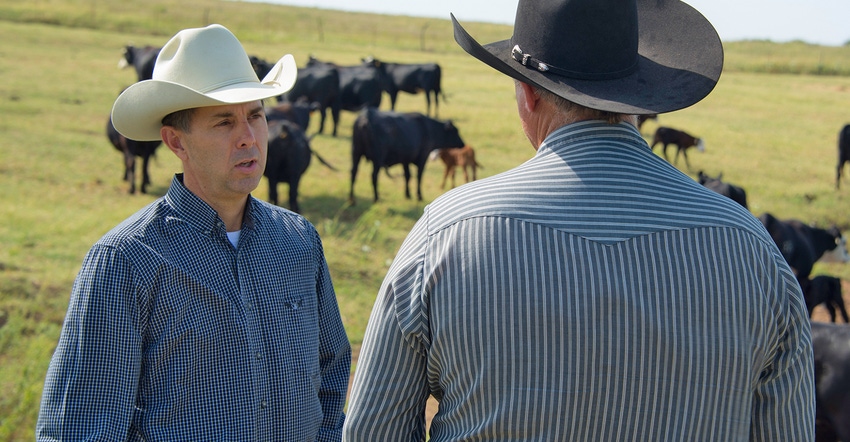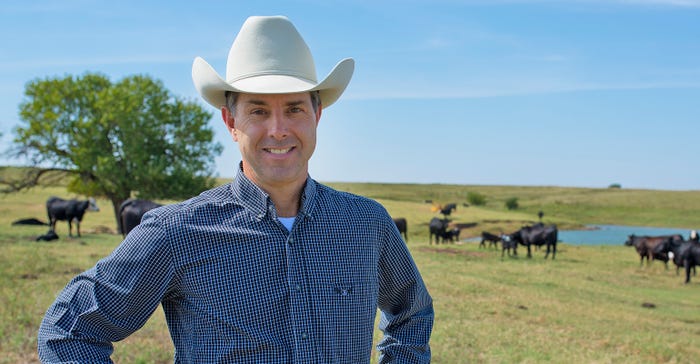August 30, 2017

Editor's note: This is the first story in a series exploring the benefits of fitting the cow to the environment.
How much muscle do we need in a commercial beef cow?
That question intrigues Oklahoma State University Extension beef cattle specialist David Lalman, who believes that ranchers need to be cautious going forward, as the aggressive selection for muscle and growth is leading to greater mature weight and less body fat composition in mature cows.
"The trend for more muscle is continuing, and some producers and researchers are now starting to recognize the potential antagonism between more muscle vs. reproductive performance," Lalman says.
"When you gradually select for more muscle over time, you have to make the animals heavier to keep from giving up reproductive performance — and then you start losing out on efficiency of the cow."

BUILDING EFFICIENCY: David Lalman, Oklahoma State University Extension beef cattle specialist, says there is a range of mature cow weights that represent the sweet spot in cow size.

If that doesn't hit home, consider the following.
"Think about the very serious female bodybuilders. They basically have no reproductive capacity," Lalman notes. "That's obviously an extreme example, but extreme musculature and reproduction do not go well together."
Lalman says it's clear that producers don't want market discounts because their calves aren't stout enough, leading to excessive yield grade 4 and 5 carcasses and associated discounts in finished cattle. However, there are numerous ways to avoid this without having an overly muscled cow herd.
"Crossbreeding with a terminal sire is one of the best ways to get at that," Lalman says. "Match the cow to the environment and the bull to the market."
Outstripping forage
Similar to muscle and growth, he continues, the genetic trends of various breed associations indicate that in the popular British breeds, aggressive selection for milk continues at an alarming pace.
"In many cases, we're selecting animals that have more genetic potential than our forage can support," he emphasizes. "Why would you want to have a cow in Oklahoma, Wyoming, Iowa or some other state where you have to artificially modify the environment with expensive inputs to keep from having a 70% pregnancy rate?"
Lalman urges producers to be aggressive when it comes to challenging their cows.
"Let the cows tell you which ones fit your environment, and which ones don't," he says. "If your ranching operation is designed to maximize use of homegrown forage with minimal external inputs, selecting for more production may be a waste of time — and most likely, money — because a low-input forage production environment may not be able to support more production."
Lalman adds: "Assuming milk, muscle and growth in a ranching operation have kept up with industry trends, more than likely your forage alone cannot support more milk, faster growth and higher weaning weights."
In the late 1960s, for example, many producers were feeding three-quarters of a ton of harvested hay to beef cows, Lalman says. Today, that number is nearing 2¼ tons of hay per cow per year.
"That's a very big difference, but it really hasn't impacted weaning weights in commercial operations," he stresses.
"Input costs are higher today because we have gradually artificially modified the environment. Feeding more hay for longer periods through the fall, winter and spring is just one example."
Early-born heifers boost success
How does a commercial beef producer know when cows are fitting the environment?
"You know you're getting there when you have not artificially modified the environment over time, yet a cow has weaned a healthy, thrifty calf every year for 10 years without missing a single one," says Lalman.
He then gives an example: "You know your cow's a real rock star if she has calved early in the calving season each of those 10 years, and all of her calves have weighed more than 50% of her weight adjusted to a body condition score 5."
Producers can start working in this direction by continually keeping only those heifers that are born early and breed early, Lalman says.
"Young cows that survive these criteria and then breed early during their second breeding season are a precious commodity, as that pregnancy is the most challenging reproductive event in their lifetimes," he emphasizes. "You can't go wrong if you follow these simple boundaries. You won't be accidentally keeping reproductive problems."
In cases where heifers are born late or breed late, their immune systems may not have been able to fight off a marginal disease challenge, resulting in a lost early pregnancy, says Lalman, adding that the nutrients supplied by the forage may not have been adequate to meet their higher requirements — or it could be that they were too thin and didn't cycle early enough.
"By always keeping early-born heifers and purchasing bulls out of cows that always have calves early in the season, you'll wind up with a cow herd that, from a reproductive standpoint, will match your environment and management very well," Lalman maintains.
Waggener writes from Laramie, Wyo.
About the Author(s)
You May Also Like




